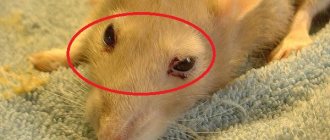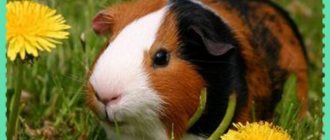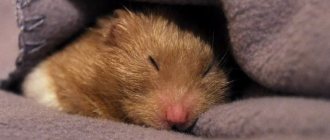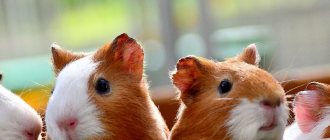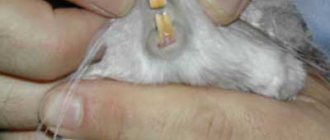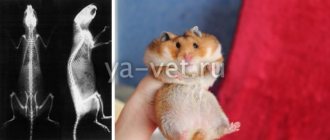Diarrhea in chinchillas is a pathological condition, among the signs of which, first of all, are frequent bowel movements and watery feces. Diarrhea itself is not a source of disease, but rather one of its symptoms. Before you begin treating your pet, it is very important to first find out the cause of the diarrhea. Pathological conditions of the body that lead to diarrhea in chinchillas include various types of infectious and invasive diseases, poisoning and dysfunction of the animal’s gastrointestinal tract. The signs of various diseases can be very similar, so only the animal’s attending physician can accurately determine the correct diagnosis.
Diarrhea in chinchillas is a pathological condition, among the signs of which, first of all, are frequent bowel movements and watery feces. Diarrhea itself is not a source of disease, but rather one of its symptoms. Before you begin treating your pet, it is very important to first find out the cause of the diarrhea. Pathological conditions of the body that lead to diarrhea in chinchillas include various types of infectious and invasive diseases, poisoning and dysfunction of the animal’s gastrointestinal tract. The signs of various diseases can be very similar, so only the animal’s attending physician can accurately determine the correct diagnosis.
Signs
Very often, owners confuse diarrhea with soft feces. Soft stools are when boluses are still formed. Diarrhea is a foul-smelling, dark or green liquid. In the case of just soft stool, the chinchilla is active and, except for dirt on its paws and in the cage, no changes occur in its condition. Most likely, the small animal was overfed with something or a new product was introduced into the diet.
Signs of diarrhea in a chinchilla:
- depressed state;
- frequent loose stools;
- loss of appetite;
- dehydration (rare urination, dry mucous membranes);
- fever.
Manifestations of gastrointestinal diseases
Non-infectious forms of gastric upset can also cause diarrhea in a chinchilla, the treatment of which largely depends on the type of disease. A sudden change in diet, poor nutrition and the use of low-quality food can lead to various forms of catarrhal inflammation. In addition to diarrhea, symptoms of their occurrence include:
- reluctance to take food;
- depressed state;
- adhesion of excrement residues;
- “swelling” of the butt area.
The presence of watery liquid-brown feces in the animal, sneezing and mucous discharge from the nose are signs of catarrhal catarrh. Brown feces of dark tones with the smell of rot indicate the presence of alkaline catarrh. The occurrence of frequent bowel movements, accompanied by liquid feces with a sour smell and bubbles, are symptoms of sour catarrh. Each catarrhal form of a non-infectious disease requires urgent treatment, an effective plan for which is drawn up by a veterinarian and requires strict adherence to all instructions. Timely assistance will prevent the imminent death of the chinchilla.
Causes of diarrhea in chinchillas
- A sick nursing mother often infects babies, for whom diarrhea is especially dangerous.
- Poisoning. If a chinchilla eats irritating or toxic food, for example, coarse salt, grain treated with pesticides, poisonous plants, fertilizers, household chemicals.
- Wrong diet. For example, if the pet was overfed, or suddenly changed one food to another. In young chinchillas, this may be due to the replacement of mother's milk with food. The cause may also be stale water or spoiled food, such as moldy hay. Chinchillas are sensitive to any deviation from the diet norms, so you should adhere to clear and strict feeding rules.
The owner must be 100% sure of the quality of the chinchilla’s food: that the grain is not treated with pesticides, that the hay is fresh, and that it does not contain poisonous herbs. For example, the following plants are especially dangerous for chinchillas: lily of the valley, foxglove, henbane, datura, buttercup, adonis, hellebore, honeysuckle.
Diarrhea is a consequence of the following diseases:
- Gastrointestinal diseases. Usually these are non-infectious diseases associated with inflammation of the mucous membranes of the stomach and intestines, dysbacteriosis - colitis, enterocolitis, gastritis, flatulence or bloating, tympany.
- Bacterial and infectious diseases - viral enteritis, enterotoxemia, colibacillosis, pasteurellosis, etc.
- Parasitic diseases - worms and protozoa - can cause diarrhea in chinchillas. The most common are trichocephalus, nematodes, trichostrongylids, and anoplocephalidosis.
- Stress. For example, when changing the situation, if there is a need to transport an animal. This often happens after visiting a veterinary clinic or exhibition. Or in case of change of owner.
Treatment of diarrhea in infectious diseases
The occurrence of diarrhea can be a consequence of damage to the chinchilla’s body by various types of infections. The cause of prolonged diarrhea may be infection with viral enteritis, melioidosis, enteretoxemia, pasteurellosis, caseous lymphadenitis and colibacillosis. One of the components of treatment for infections in chinchillas is the restoration of intestinal microflora, adhering to a diet limited to the consumption of soft hay and water. You can also give the animal the opportunity to chew on oak bark or activated carbon, but if diarrhea and other symptoms persist, you must immediately seek qualified help from a specialist.
First aid
Foul-smelling diarrhea is considered dangerous, as well as if the animal refuses water and is apathetic. In this case, you need to immediately show the chinchilla to a veterinarian, as these are life-threatening symptoms for the animal. It is possible that there is no particular reason for concern, but only a specialist can confirm this. Be sure to remember if you added anything new to your chinchilla’s diet. Inspect the chinchilla's hay and food to see if there are any parasites or fungus there. A drinking bowl with water must be disinfected, for example, doused with boiling water and soda or a chlorine-containing preparation. After this, the drinking bowl should be rinsed thoroughly and fresh, high-quality water should be poured into it. The cage should also be thoroughly cleaned, washed, and the filler changed. Keep the cage clean!
Do not delay treatment. If the boluses are not smelly, then you can completely get by with folk remedies.
- Try to get the animal drunk. It is necessary to replenish the deficiency of fluid and electrolytes. You can prepare a drinking solution yourself (for 0.5 liters of water, ¼ tsp salt, ¼ tsp soda, 2 tbsp sugar) or buy a ready-made solution at the pharmacy, for example, rehydron, and prepare the solution according to the instructions . The chinchilla should be given the solution throughout the day as needed.
- Strict diet. Do not feed your chinchilla treats; the best food for her when she has diarrhea is coarse hay and clean water.
- Feed dry pomegranate peel to a chinchilla - this product has good fixing properties.
- You can give activated carbon at the rate of 1 tablet per day.
- You can add a decoction of oak bark to drinking water; it is a good astringent, but not all chinchillas like it. To prepare the decoction you need 1 tsp. oak bark pour 100 ml of boiling water, cover tightly and leave for several hours, then strain. The prepared broth should be stored in the refrigerator. This decoction should be added to drinking water at the rate of 15 ml per 300 ml of water. You can also simply add pieces of oak bark to the feeder with other food. Burnet grass also has a good astringent and antibacterial effect. It can also be purchased at a pharmacy.
- A sick chinchilla may well benefit from boluses from a healthy one - they adjust digestion. Boluses are diluted in water and then given to the sick animal.
Symptoms
When talking about symptoms, it is important to understand the difference between soft stool and diarrhea. Soft stools are normal and just a reaction of the intestines to this or that food. It is distinguished by softer, but clearly defined feces. With diarrhea, feces turn into a dark or greenish slurry that has a pungent and unpleasant odor. More severe cases are accompanied by the presence of large amounts of mucus and bloody discharge in the stool.
The first symptoms of the disease:
- Loose and very frequent stools
- Increased body temperature
- Cramps,
- Loss of appetite,
- Apathy,
- Painful shocks and colic,
- Gas formation.
Diarrhea is almost always accompanied by severe dehydration and enlargement of the abdominal walls.
Medical assistance
If the diarrhea is serious and traditional methods do not help, you need to take medication.
- Phthalazole is an inexpensive antibacterial drug, sold in any pharmacy - 1 tablet. 1 per day.
- Bifitrilak - given at the rate of 0.1 grams per kilogram of animal weight. This is a veterinary drug.
- Smecta is an adsorbent, dilute 1 sachet per 50 ml of water. Give 2-3 times a day, 2-3 ml.
- Liarsin - 1 tab. 1-2 times a day
- To improve intestinal microflora, you can use the following “human” preparations of lactobacilli - Bifidumbacterin, Linex, Yogurt, Lactobacterin. Divide the contents of the capsule into 6 parts - give 1 part 3 times a day with water from a spoon.
- There is a special veterinary priobiotic - Vetom 1.1. Recommended for bacterial and viral infections such as salmonellosis, coccidiosis, dysentery, colibacillosis, hepatitis, rotavirus and paraviral enteritis. Improves intestinal function. Take according to instructions.
- Enterofuril is an intestinal antibiotic in suspension, take 0.2 ml 2 times. per day.
- Hilak-forte for normalizing intestinal microflora - 10-20 drops of the drug per 0.2 liter of water.
- Enterosgel - adsorbent 0.25 tsp. 2–3 r. in a day.
- Enterol 250 is an intestinal antibiotic. Give 1 part 2 times a day for 3 days.
- The veterinary drug for nonspecific diarrhea Pro-Kolin+ is given once a day. This feed additive contains beneficial microorganisms, kaolin, which adsorbs microorganisms and toxic substances, and pectin, a natural substance that protects the intestinal mucosa.
Nutrition
Chinchillas need to be fed well and nutritiously, this will ensure the maintenance of their health and proper development. Their diet is not particularly wide, and it should be selected carefully. It is believed that these animals themselves choose what to eat. They choose from the products that are given to them exactly what they need now. Chinchillas often change their taste preferences; they may want different foods every day.
Maybe they really feel the need for this or that food, or they simply don’t remember food. The belief that chinchillas have taste preferences is partly incorrect.
These pets are treat lovers and will therefore eat what they want first, even if it is not very healthy for them.
It is better for the owner of a chinchilla to monitor his pet’s diet himself. You don’t need to constantly give the animal what it likes; you can offer it a choice of one product, for example, berries or herbs. To stimulate appetite and diversify the diet, sometimes, about once every six months, change your pet’s main specialized food.
Composition of a chinchilla's diet:
- basis – specialized food, water, hay;
- additionally give portions of food and green plants, fruits, berries, grains, “Hercules”;
- treats - they are given a little at a time when exercising with the pet in order to stimulate it; these can be products from an additional diet: dry fruits, berries, nuts, and so on;
- vitamins – they are necessary to maintain the health of your pet.
Constipation
With a prolonged absence of stool, constipation develops in the chinchilla, and in severe cases, coprostasis. In order not to lead to a critical condition, you need to help the rodent empty its intestines and begin treatment.
To do this, use Vaseline oil, which can be purchased at a regular pharmacy; it is safe and is not absorbed in the intestines of a rodent. During the day you should drink about 10-15 ml of oil, in small volumes every hour. The oil will help soften the stool and improve the peristalsis of the intestinal tube.
You can do a small enema with water and oil, but this procedure must be done very carefully so as not to frighten the animal. Abdominal massage can also have a positive effect on the functioning of the digestive tract.
What to do with prolonged constipation? Without wasting precious time, go to the doctor, because with multiple accumulations of feces, intoxication of the body develops and sometimes surgical intervention is required.
Prevention
The main preventive measures include:
- do not overfeed your chinchilla with succulent herbs, give such food carefully;
- introduce new food gradually;
- check the quality of food in advance;
- for soft boluses, contact your veterinarian. The stool should be hard;
- eliminate stress in your pet;
- Keep the cage clean, change the water regularly;
- Use sand exclusively for bathing the animal.
When consuming grapes, persimmons, cabbage, beets, seeds, nuts, sweets, dairy products, leaves of indoor plants, wet grass and leftover food from the owners' table in large quantities, digestive system dysfunction is noted.
Rodents love sweets, despite this - you should not pamper your animal with these products, as their stomach cannot cope with digestion.
Priority should be dried apricots, prunes, sprouted wheat grain, a small slice of watermelon or melon.
Flatulence
This pathological process most often develops in the spring and summer, when owners happily, but without measure, begin to feed their pets fresh, green and juicy food. From such an abundance, fermentation processes develop in the rodent’s intestines, accompanied by the release of large amounts of gas. Especially in this case, green legumes (clover, alfalfa) are dangerous.
The abdomen sharply increases in size, the pet develops severe pain, the number of respiratory movements becomes more frequent, and hypothermia may develop (temperature drops to 34 degrees).
In this case, urgently give the animal an adsorbent: activated carbon, children's espumisan in syrup or similar drugs that can be bought at a regular pharmacy. Try to increase the chinchilla's mobility, but very carefully, massage the abdominal wall.
If there is no dynamics, you need to inject an anesthetic drug and an antispasmodic, for this you need to consult a doctor. Buscopan or No-shpu are often done.
In case of flatulence, they endure a day of fasting and begin to feed hay first.
Inbreeding
Another equally important disease is inbreeding. This disease leads to the death of the animal. Inbreeding is consanguineous inbreeding, as a result of which congenital deformities arise, mainly internal ones; they cannot be determined by external signs; only an autopsy can show them.
In addition to feeding, proper handling of the animal at home is also important. These animals are very emotional, have high intelligence, and are susceptible to stress. As a result, cardiovascular diseases occur. Getting used to something should happen gradually. Each animal has a unique character that requires a specific approach. A little patience and everything will definitely work out!
We wish that your animals never get sick!


